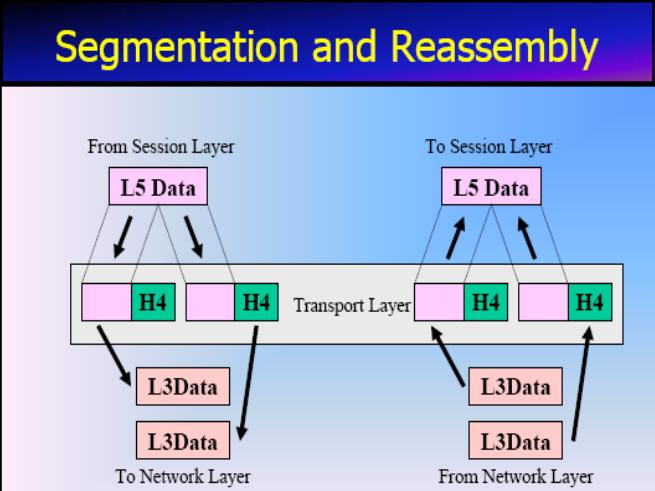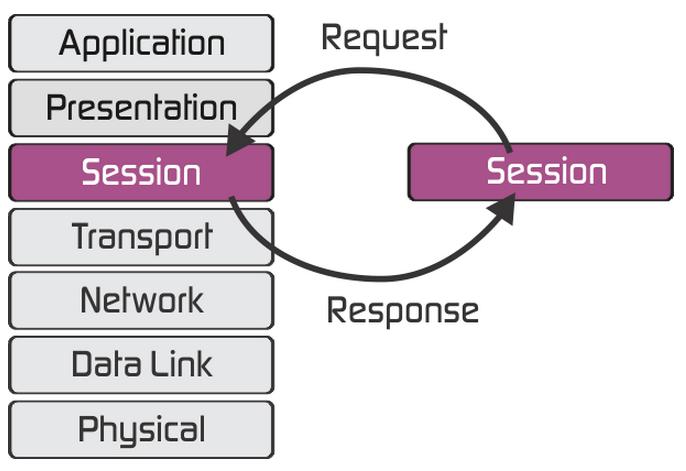Jump to Section
Introduction
OSI(Open System Interconnection) model is the reference model that describes how different model layer communicate over the network. Open system interconnection mainly defines the relationship between different layers over the internet. The main purpose of this reference model is to transfer digital data among the seven layers. The transmission among different layer is done between two endpoints.
ISO (International Organization for Standardization): ISO is the organization and OSI is the reference model.
This model is called the ISO OSI reference model because it deals with systems that open for communication to the other system. So, An OSI (open system interconnection )reference model is a set of protocols that allows any two different systems to communicate regardless of their underline architecture over the network. The purpose of the OSI reference model is to show how to facilitates communication between different systems without requiring changes to the logic of underlying hardware and software.
Layered Architecture
The OSI model is composed of seven ordered layers.
- Physical Layer.
- Data Link Layer.
- Network Layer.
- Transport Layer.
- Session Layer.
- Presentation Layer.
- Application Layer.
Organization Of the Layer
The seven layers can be thoughts of belonging two- three subgroups. Layers one, two and three (Physical, Data Link, and Network Layer) are the network support layers. So, they deal with the physical aspects of moving data from one device to another device.
Layers five, Six and Seven (Session, Presentation, Application) can be thoughts of as the users support layers, They allow interconnection among unrelated software system. Therefore, the main work of Transport Layer is used to maintain data over the net. and ensures that what the lower layer has the transmitted in a form that the upper layers can use.
Note: The upper OSI layer(five, six and seven) are almost always implemented in software, it is not hardware, the lower layer is the combination of hardware and software except for Physical layer.
Layers in the OSI model
Physical Layer

Physical Layer communicates with the mechanical(hardware) and electrical specification of the interface and transmission media. The physical layer is responsible for the movement of individual data from one hop(node) to next hop.
Other responsibilities of Physical layers :
- Physical cooperate of interface and media: This layer defines the features of the interface between the devices and the transmission media, it also defines the type of transmission media.
- Representation of data: Two-bit transmitted, data must be encoded to the signal, electrical and optical. The physical layer defines the type of encoding (how zero and one change two signals).
- Synchronization of data: In this, process the sender and receiver must not only use the same data rate but must also be synchronized at the data level, in other words, the sender and receiver clock must be synchronized.
- Linc Configuration: The physical layer concerned with the connection of the devices to the media either point to point configuration or multipoint configuration.
- Physical Topology: The physical topology defines, how devices are connected to make a network, Ring, Bus, Star etc.
- Transmission media: This layer support different transmission mode such as Simple, Half-duplex and Full-duplex.
Data Link Layer
The data link layer is responsible for moving the frame from one hop to next hop.
Other responsibilities of the data link layer some of them are
- Framing: Data link layer divides the stream of data received from the network layer into manageable data units called frames.
- Data Link: Frames given to the different system on the network.The data link layer adds a header to the frame to define the sender and receiver or/and receiver of the frame.
- Flow Control: If the data rate in which data receives by the receiver is less then the rate produces in the sender, the data link layer imposed a flow of control mechanism to prevent overwhelming the receiver.
- Error ControlAt time of Running): The data link layer adds the reliability to the retransmit damages frames over the network. It also uses a mechanism to recognize duplicate frame.
- Acces Control: Data link layer define when two or more devices are connected to the same link, data link layer protocols are necessary to determine which device has control over the link at any given time.
Network Layer
The network layer is responsible for the delivery of packets from one hop to other or the original source to the final destination. So, network layer decides the path via which the packets are to be transmitted from one source to another source over the network. This is the third level of OSI reference model and mostly used.
Transport Layer
The transport layer is responsible for the delivery of a message from one process to another(ie process to process).
Other functions of the transport layer:
- Transport layer performs the function to manage data from source to destination delivery means delivery not only from one computer to other computer but also from a specific process(running program on one computer to a specific process on the other).
- Transport layer must their fore include a type of address called a “PORT ADDRESS”.
Note: The network layer takes each and every packet to the correct computers, the transport layer gets the entire message to the correct process on that computer.
- Segmentation and Assembly: It segment data first and then reassemble and transfer from one end to another end.
- Connection Control: It also maintains the connection process ie connectionless and connection-oriented.
- Flow Control: Transport layer manage the flow control of data over the internet. Transport layer like Data link layer is responsible for flow control. However, flow control at this layer performs end to end rather than across a single link. End to end means the flow of data is transfer from one node to another node over the internet(source to destination).
- Error Control: One of the major function of the Transport Layer is Error Control mechanism. Like the data link layer, the error control performs process to process rather than across a single link. Process to process means, transfer of data from simultaneously from one hope to another hop(node).

Session Layer
Session Layer is the fifth layer of the OSI reference model. This layer mainly focuses on connecting and terminating session over the network. The Session Layer is the network dialog control layer. This layer establishes, maintain and synchronizes the interaction between communicating system. Session layer maintains the connection over the internet and synchronizes the flow of data in the synchronized way. Synchronization up to two types, one processes synchronization and second is data synchronization.
Session Layer other responsibilities, some of them are-
Dialog Control: Dialog Control is the first function of the session layer, it manages the dialog control activity. The session layer allows entering into a dialog. This layer allows the communication between two processes to take place either in half duplex and Full Duplex. Here half duplex and full duplex is the communication media over the internet or channel.
Synchronization: Synchronization is the second responsibility of the session layer. Synchronization is the process where two threads are accessing the same storage space at the same time. This process calls synchronization.
Terminating Communication: Session layer is responsible for terminating the connection over the internet.
Connection Failure: This layer is also responsible for checking for connection failure.
Reconnection: Session layer responsible for reconnection over the internet if the connection gets cut off.
Secure Connection: Also, this layer is responsible for maintaining a secure connection to the channel or the network.
 Presentation Layer
Presentation Layer
The presentation layer is the sixth layer of the open system interconnection reference model. This layer is concerned with syntax and semantics of the information exchanged between two systems.
The presentation layer is the layer which manages the rules and set of protocols to transfer data over the channel. This layer uses one of the most important protocols that are Http protocol(Hyper Text Transfer Protocol).
Other specific responsibilities of this model are-
Translation: Translation is the first function of the presentation layer, it translates different encoding system from one format to another format. Because different mechanism used different encoding (BCD, BCSI) system. So, the presentation layer is responsible for interoperability between these different encoding systems.
Encryption: Encryption is the most secure function of the presentation layer. First of all, Encryption means that the sender transforms the original information to another form and sends the resulting message out over the network. decryption uses to transmit data in first forms.
Compression: Data compression reduces the number of bits contained in the information.
Data Conversion: Presentation layer also maintain the data conversion.
Application Layer
The application layer is the last layer of the OSI(open system interconnection reference model). Application layer enables the users( human or software) to access the networks.
Note: This layer is responsible for providing the services to the user.
Other Responsibilities of the application layer are-
Mail Services: This is the first function of the application layer. This application provides the basis for email forwarding and storage.
Directory Services: This application provides distributed data source and access for global information about various objects and services. Distributed means the channel which uses at world level.
File Transfer, Access and Managed: This layer is also responsible for transferring of a file, access the file and maintain the whole file over v the internet.
Network Virtual Terminal: Application layer also manages the Network Virtual Terminal. It is a software version of a physical terminal and allows a user to log on a remote host.
Summary/Conclusion of the Layer
Physical Layer: This layer is responsible for transmitting bit over a media, to provide the mechanism and electrical.
Data Link Layer: To organize bit into a frame. Also, this layer is responsible for delivery of frame from one hop to another hop(node).
Network Layer: To moves the packets from original source to final destination. Also, It provides internetworking.
Transport Layer: This layer is responsible for to provide the reliable process to process message delivery and error recovery.
Session Layer: To establish, manages and terminate the session.
Presentation Layer: Presentation Layer is responsible for encryption and decryption of data over the network furthermore It transmits data from one format to another format.
Application Layer: This layer is the last layer of OSI reference model, It allows access to network resources.
Conclusion
OSI(Open System Interconnection) model is the reference model that describes how different model layers communicate over the network. ISO is an organization and OSI is the model. Therefore, this model consists of seven different layers. OSI layers which are the backbone of OSI model. In this article also explained how seven layers interact with each other over the network and also different responsibilities of the layers.
In addition, OSI model is the best model to transmit data, managed session, and terminating session.
I hope this article will be more beneficial for the new learner of the OSI reference model.
- Difference Between SQL and MySQL - April 14, 2020
- How to work with Subquery in Data Mining - March 23, 2018
- How to use browser features of Javascript? - March 9, 2018










 Presentation Layer
Presentation Layer

